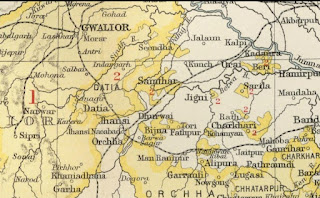Datia State was a princely state in subsidiary alliance with British India. The state was administered as part of the Bundelkhand Agency of Central India (a political agency of British Raj, managing the relations of the British government with the princely states of the Bundelkhand region). It lay in the extreme north-west of Bundelkhand, near Gwalior, and was surrounded on all sides by other princely states of central India, except on the east where it bordered upon the United Provinces of Agra and Oudh.
Coin of Datia State, Bhawani Singh, 1788-1899 AD
Datia State in the Imperial Gazetteer of India
Datia, had formerly been a State in the Bundelkhand region founded in 1626 AD. The ruling family were Rajputs of the Bundela clan, and they descended from a younger son of a former raja of Orchha. It came under British control with other territories in Bundelkhand by the Treaty of Bassein, concluded with the Peshwa in 1802. The ancient title of the family was Maharaja Rao Raja, but in 1865, the government recognised only the title of Maharaja.
Coat of Arms
Coat of Arms of Datia State
It was second highest in rank of all the Bundela states after Orchha, with a 17-gun salute and its Maharajas bore the hereditary title of Second of the Princess of Bundelkhand. The land area of the state was 5,500 square km. The Maharaja maintained a military force of 945 cavalry, 5200 infantry and 124 guns. The motto of the family is ''Wir dalap Sharandah'' or ''Lord of the Brave Army, Giver of Refuge''
Rao Bhagwan Rao, the first Rao of Datia and Baroni 1626/1656, received Datia and Baroni from his father Raja Bir Singh Deo of Orchha in 1626 and established his own state. He died in 1656 AD.
Maharaja Bir Singh Deo built about 52 monuments including the famous Datia Palace also called Bir Singh Palace/ Datia Mahal. Historian Abdul Hamid Lahori came to the city with Shah Jahan in November 1635 and said that the palace was 80 meters long and equally wide. It was a very beautiful and strong palace. It was built in nine years at a cost of 35 Lakh rupees and represents Mughal and Rajput architecture. Situated on an isolated rock it is visible from a long distance
Bir Singh Deo Palace, Datia
The Govind Niwas Palace, once the residence of the 10th ruler of Datia state, Maharaja Lokendra Bahadur Sir Govind Singh Ju Dev, is now a famous Hotel surrounded by rich flora and fauna.
Maharaja Govind Singh Judev Bahadur, 1886-1951
Govind Niwas Palace
Datia City view, 1872
After India's independence in 1947, the Maharaja of Datia acceded unto the Dominion of India, it later merged with the Union of India. Datia, together with the rest of Bundelkhand agency, became part of the new state of Vindhya Pradesh in 1950. Vindhya Pradesh was created in 1948 as Union of Baghelkhand and Bundelkhand States, shortly after India's independence, from the territories of the princely states in the eastern portion of the former Central India Agency. In 1956, Vindhya Pradesh state was merged with certain other areas to form the state of Madhya Pradesh.
Coins of Datia State
1/2 Paisa, Bhawani Singh, 1796-1817 AD, copper, weight 6.1 gm, mint mark on reverse
1 Paisa, Bhawani Singh, 1816-1903 AD, copper, weight 12.2 g, RY 32, Datia mint mark on reverse
1/2 Rupee, 1894-1900, silver, weight 5.4 gm, with inscription and date on obverse and mint mark and regnal year 3 on the reverse
One Rupee, Raja Shahi series, 1758-1774 AD, silver, weight 10.9 gm with partial date in AH visible on obverse and Regnal year 3 on reverse

















No comments:
Post a Comment
Any inputs or feedback is welcome!